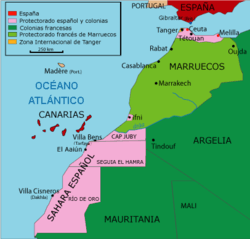Tangier International Zone
| Tangier International Zone | ||||||||||
| International Zone | ||||||||||
| ||||||||||
|
| ||||||||||
 Tangier and the International Zone | ||||||||||
| Capital | Tangier | |||||||||
| Languages | Moroccan Arabic, Berber languages, Judeo-Moroccan, Haketia, Spanish, French, English | |||||||||
| Religion | Islam, Christianity, Judaism | |||||||||
| Political structure | Special territory | |||||||||
| Historical era | Interwar period | |||||||||
| • | Established | 1924 | ||||||||
| • | Spanish occupation | 14 June 1940 - 11 October 1945 | ||||||||
| • | Disestablished | 1956 | ||||||||
| Area | ||||||||||
| • | 1924 | 373 km² (144 sq mi) | ||||||||
| Population | ||||||||||
| • | 1939 est. | 60,000 | ||||||||
| • | 1950 est. | 150,000 | ||||||||
| Currency | Pound sterling | |||||||||
| ||||||||||
| Today part of | | |||||||||
The Tangier International Zone (Arabic: منطقة طنجة الدولية Minṭaqat Ṭanja ad-Dawliyya, French: Zone Internationale de Tanger, Spanish: Zona Internacional de Tánger) was a 373-square-kilometre (144 sq mi) international zone centered on the city of Tangier, North Africa under the joint administration of France, Spain, and Britain (later Portugal, Italy, Belgium, the Netherlands, Sweden, and the United States) attached to Morocco, then under French protectorate that existed from 1924 until 1956 with its reintegration into Morocco.
The zone was governed in accordance with the Tangier Protocol, although the Sultan of Morocco retained nominal sovereignty over the zone and jurisdiction over the native population.[1]
The International zone of Tangier had, by 1939, a population of about 60,000 inhabitants and 150,000 by 1950.
History
To solve a disagreement among France, Spain, and Britain over its control, Tangier was made a neutral demilitarized zone in 1924 under a joint administration according to an international convention signed in Paris on December 18, 1923.[2] Although some disagreements emerged about the agreement[3] ratifications were exchanged in Paris on May 14, 1924.[4] The convention was amended in 1928.[5] The governments of Italy, Portugal and Belgium adhered to the convention in 1928, and the government of the Netherlands in 1929.

The Zone had its own appointed International Legislative Assembly, which was subject to supervision by a Committee of Control consisting of the Consuls of Belgium, France, Britain, Italy, the Netherlands, Portugal and Spain.[6] Executive power was vested in an Administrator, and judicial power resided in a Mixed Court of five judges, respectively appointed by the Belgian, British, Spanish, French and Italian governments.[6] As a result of the creation of the Mixed Court, the various European powers withdrew the consular courts that previously exercised jurisdiction there.[7]
The Zone had a reputation for diversity of culture and religion.
Spanish troops occupied Tangier on June 14, 1940, the same day Paris fell to the Germans. Despite calls by the writer Rafael Sánchez Mazas and other Spanish nationalists to annex "Tánger español", the Franco regime publicly considered the occupation a temporary wartime measure.[8] A diplomatic dispute between Britain and Spain over the latter's abolition of the city's international institutions in November 1940 led to a further guarantee of British rights and a Spanish promise not to fortify the area.[9] In May 1944, although it had served as a contact point between him and the later Axis Powers during the Spanish Civil War, Franco expelled all German diplomats from the Zone.[10] The territory was restored to its pre-war status on October 11, 1945.[11] In July 1952 the protecting powers met at Rabat to discuss the Zone's future, agreeing to abolish it. Tangier joined with the rest of Morocco following the restoration of full sovereignty in 1956.[12]
Further reading
- Beevor, Antony (2006). The Battle for Spain: The Spanish Civil War 1936–1939. London: Weidenfeld & Nicolson. ISBN 0-29784832-1.
- Finlayson, Iain (1992). Tangier: City of the Dream. HarperCollins. ISBN 0-00217857-5.
- Payne, Stanley G. (1987). The Franco Regime, 1936–1975. Madison: University of Wisconsin Press. ISBN 978-0-299-11070-3.
- Stahn, Carsten (2008). The Law and Practice of International Territorial Administration: Versailles to Iraq and Beyond. Cambridge: Cambridge University Press. ISBN 978-0-52187800-5.
- Stuart, Graham H. (July 1945). "The Future of Tangier". Foreign Affairs. Council on Foreign Relations. 23 (4).
- Stuart, Graham H. (1955). The International City of Tangier (2nd ed.). Stanford: Stanford University Press.
See also
References
- ↑ Stahn 2008, pp. 57–58.
- ↑ Stahn 2008, p. 57.
- ↑ Stuart 1955, p. 80.
- ↑ "Convention regarding the Organisation of the Tangier Zone, with Protocol relating to Two Dahirs concerning the Administration of the Tangier Zone and the Organisation of International Jurisdiction at Tangier, signed at Paris, December 18, 1923 [1924] LNTSer 187; 28 LNTS 541". 1924.
- ↑ "Agreement revising the Convention of December 18, 1923, relating to the Organisation of the Statute of the Tangier Zone and Agreement, Special Provisions, Notes and Final Protocol relating thereto. Signed at Paris, July 25, 1928 [1929] LNTSer 68; 87 LNTS 211". 1928.
- 1 2 Stuart 1945.
- ↑ Morocco (Tangier Zone) Order in Council, 1925, The London Gazette: no. 33050. pp. 3547–3548. 26 May 1925.
- ↑ Payne 1987, p. 268.
- ↑ Payne 1987, p. 274, note 28.
- ↑ Beevor 2006, pp. 152, 464.
- ↑ "Reestablishment of the International Regime in Tangiers". Department of State Bulletin. Department of State. XIII (330): 613–618. October 21, 1945.
- ↑ "Final Declaration of the International Conference in Tangier and annexed Protocol. Signed at Tangier, on 29 October 1956 [1957] UNTSer 130; 263 UNTS 165". 1956.
